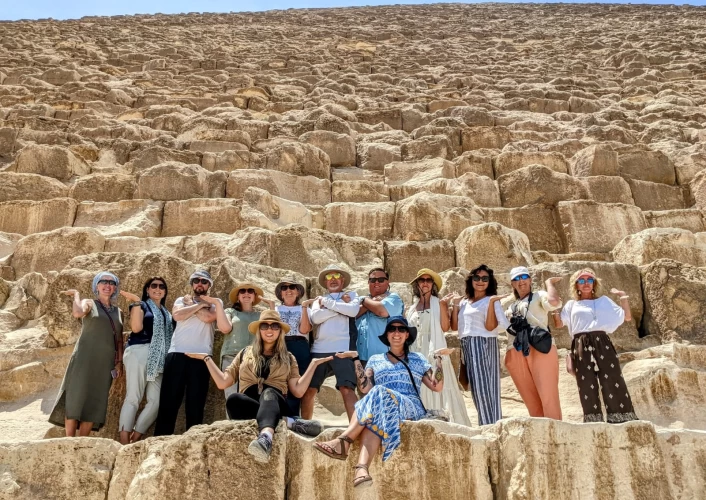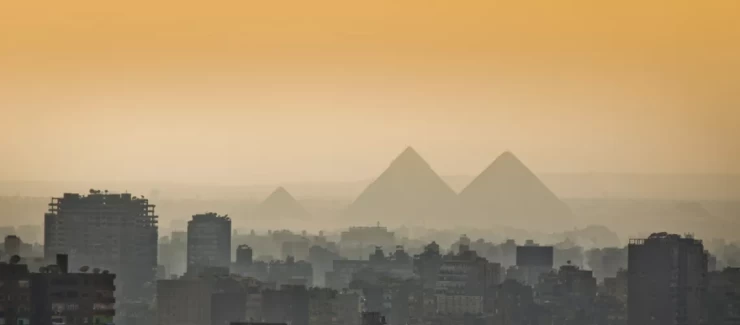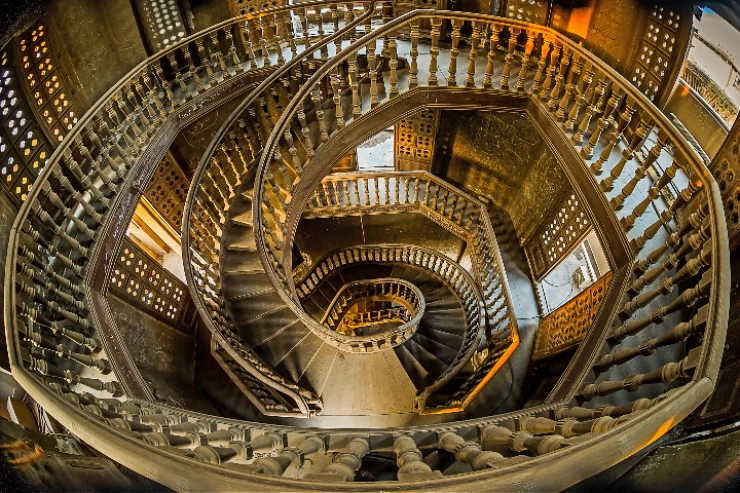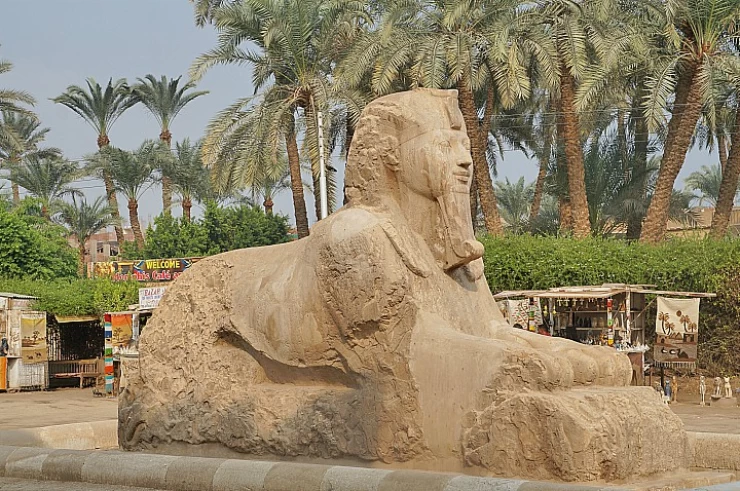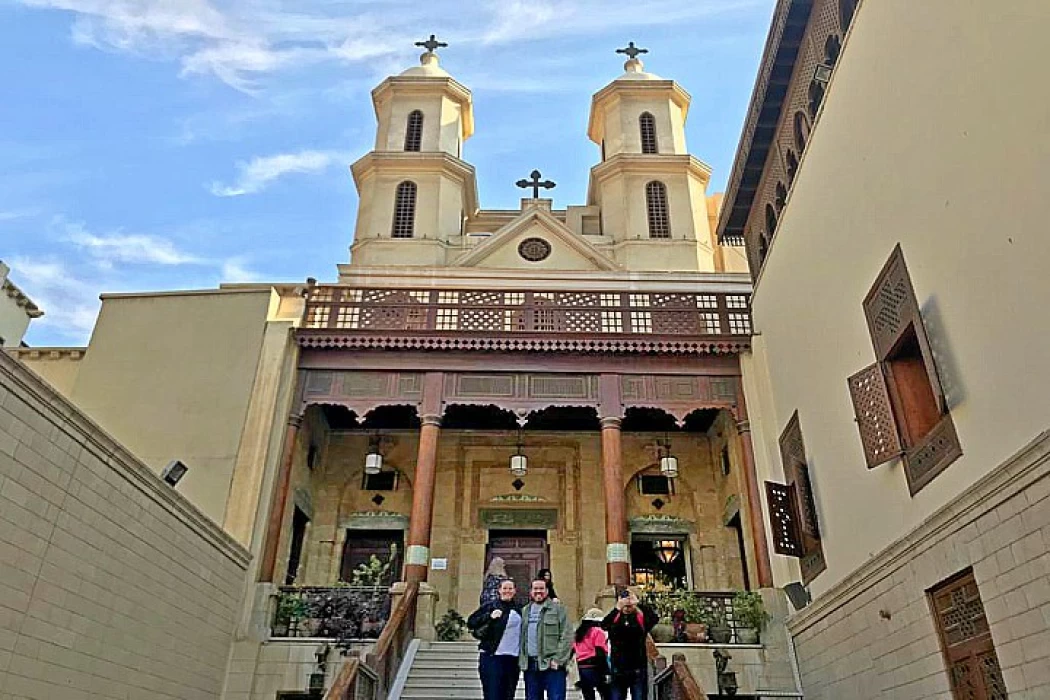
El Cairo Copto | El Viejo Cairo
El Cairo copto es una parte del Viejo Cairo que abarca la fortaleza de Babilonia, el museo copto, la iglesia colgante, la iglesia griega de San Jorge y muchas otras iglesias coptas y sitios históricos. Se cree en la tradición cristiana que la Sagrada Familia visitó esta área y se quedó en el sitio de la Iglesia de los Santos Sergio y Baco (Abu Serga), por eso las personas que planean sus Excursiones de un día en El Cairo se aseguran de ver esta parte del Viejo Cairo. El Cairo copto fue un bastión para el cristianismo en Egipto hasta la era islámica, aunque la mayoría de los edificios actuales de las iglesias en el Cairo copto se construyeron después de la conquista musulmana de Egipto en el siglo VII.
Hay evidencia de asentamiento en el área ya en el siglo VI aC, cuando los persas construyeron un fuerte en el Nilo, al norte de Memphis. Los persas también construyeron un canal desde el Nilo (en Fustat) hasta el Mar Rojo. El asentamiento persa se llamaba Babilonia, que recordaba a la antigua ciudad a lo largo del Éufrates, y ganó importancia mientras que la cercana ciudad de Menfis disminuyó, al igual que Heliópolis. Durante el período ptolemaico, Babilonia y su gente fueron en su mayoría olvidados.
Se sostiene tradicionalmente que la Sagrada Familia visitó el área durante la Huida a Egipto, buscando refugio de Herodes. Además, se sostiene que el cristianismo comenzó a extenderse en Egipto cuando San Marcos llegó a Alejandría, convirtiéndose en el primer Patriarca, aunque la religión permaneció bajo tierra durante el gobierno de los romanos. Cuando la población local comenzó a organizarse hacia una revuelta, los romanos, reconociendo la importancia estratégica de la región, tomaron el fuerte y lo reubicaron cerca como la Fortaleza de Babilonia. Trajano reabrió el canal hacia el Mar Rojo, lo que aumentó el comercio, aunque Egipto siguió siendo un remanso en lo que respecta a los romanos.
Bajo los romanos, San Marcos y sus sucesores pudieron convertir una parte sustancial de la población, de las creencias paganas al cristianismo. A medida que las comunidades cristianas en Egipto crecieron, fueron sometidas a persecución por los romanos, bajo el emperador Diocleciano alrededor del año 300 dC, y la persecución continuó después del Edicto de Milán que declaró la tolerancia religiosa. La Iglesia copta luego se separó de la iglesia de los romanos y los bizantinos. Bajo el gobierno de Arcadio (395-408), se construyeron varias iglesias en el Viejo Cairo. En los primeros años del dominio árabe, a los coptos se les permitió construir varias iglesias dentro del área de la antigua fortaleza del Viejo Cairo.
La sinagoga de Ben Ezra se estableció en el Cairo copto en 1115, en lo que anteriormente era una iglesia copta que se construyó en el siglo VIII. Los coptos necesitaban venderlo para recaudar fondos para pagar impuestos a Ibn Tulun.
En el siglo XI d. C., el Cairo copto albergó la sede del Papa copto ortodoxo de Alejandría, que tiene su sede histórica en Alejandría. A medida que los poderes gobernantes se mudaron de Alejandría a El Cairo después de la invasión árabe de Egipto durante el mandato del Papa Christodolos, El Cairo se convirtió en la residencia fija y oficial del Papa Copto en la Iglesia Colgante en El Cairo Copto en 1047.
El Museo Copto se estableció en 1910 y alberga los ejemplos más importantes del mundo del arte copto.
Iglesias
Iglesia de Santa María (Haret Elroum)
Iglesia de san mercurio
Iglesia de los Santos Sergio y Baco (Abu Serga)
La iglesia colgante
Iglesia de la Santísima Virgen (Babilonia El-Darag)
Iglesia Santa Bárbara
La iglesia de san menas
Convento e Iglesia de San Jorge (El Cairo)
Monasterio e Iglesia de San Jorge (ortodoxo griego)
Las maravillas del turismo en suelo egipcio son los frutos que Cairo Top Tours pone a su alcance a través de sus agentes sobre el terreno y/o en línea.
Si siente curiosidad por la ciudad de Guiza y quiere ver cómo es y qué ocurrió allí en el pasado, puede encontrar mucha información e imágenes en "¿Es Seguro Viajar Al Desierto Blanco?". Te ayudará a saber más sobre Guiza.
Coptic Cairo is located in the center of the vast metropolis of Egypt. As the names go, Coptic Cairo is the district replete with history and antiquities—more so, stories of this country’s prominence in Christianity. The district popularly referred to as Old Cairo is one of the oldest parts of the city and is one of the best illustrations of the great melting pot that is the country’s history. People come here to appreciate the mixtures of obvious architectures of all religions—Christianity, Judaism, and Islam. This is to explain more what Coptic Cairo has to offer any tourist who wishes to visit Egypt and not just to see the Pyramids.
A Walk Through History: The Origins of Coptic Cairo
Coptic Cairo is the memory of the period when the settlement was referred to as Babylon the Great, the Roman Empire's fortress on the Nile River. As early as the 4th century, this region became a great hub for Christianity and scholarship. The transformation of this area into a religious center is attributed to the advancement of Christianity in Egypt which can be dated back to the coming of St. Mark in Alexandria in about 42 AD. Christianity expanded, leading to the construction of many churches within Egypt, with Coptic Cairo being the first.
Copt is a name that is given to the Christians from Egypt who belong to the Coptic Orthodox Church, whose doctrine is considered to have been founded by the apostle Mark. Coptic Cairo is a time waiting to be unearthed since it harbors many ancient churches, convents, and other buildings vital for the study of the growth of Christianity in Egypt and the area around it.
1. The Hanging Church (Saint Virgin Mary's Coptic Orthodox Church)
The Hanging Church, which gets its name from the position it sits in, on the upside of the Roman gatehouse of Babylon, is one of the most remarkable and magnificent landmarks in Coptic Cairo. Constructed in the third century, the church is one of the ancient churches in Egypt and is very dear to the Coptic community. The interior design of the church is unique, as it has a wooden ceiling that is crafted like Noah’s Ark, the walls are beautifully detailed, and there is an iconostasis. Visitors are treated to 110 icons depicting biblical scenes and Coptic saints, the oldest of which dates to the 8th century.
2. The Church of Sts. Sergius and Bacchus
Another olden-era church targets modern young and old Christians and lots of tourists, as it is said to have been erected in the cave where the Holy Family hid by the time they were headed to Egypt. The Church of St. Sergius and Bacchus has a mystical aura and simple beauty, which makes one feel immersed in the time of early Christians in a very strong way. The crypt where the Holy Family is said to have taken shelter is accessible to visitors, which provides a striking contrast between the ancient stories of Egypt and the Bible.
3. The Ben Ezra Synagogue
The Ben Ezra Synagogue is one of the most ancient Jewish worship centers in Egypt and is living proof that diverse religious communities may peacefully co-exist in the country. Local tradition maintains that the very synagogue is built on the ground where the Pharaoh`s daughter discovered Moses in the bulrushes. Once a Coptic church, it was turned into one in the 9th century and is an exquisite example of architectural design, comprising carved wooden panels, lovely murals on ceilings, and other historic pieces.
4. The Coptic Museum
Coptic Museum is a must-visit place if one feels like exploring more on the history of Coptic Christianity. Established in 1910, it boasts the largest collection of artifacts and artwork belonging to Copts in the world, including decorated books, clothes, and Coptic icons. This museum also opens up the world to many imaginations about the lives of early Egyptians—Christians in particular—their arts, as well as Coptic art that evolved in different climates interacting with other cultures.
5. The Monastery and Church of St. George
St. George's Church is an exceptional place, as it is one of the rare surviving round-shaped churches in the Middle East. The Greek Orthodox Church here was believed to have been erected in the 10th century; however, some sources even suggest that the primary edifice was erected in the sixth century. The monastery and church are dedicated to Saint George, who is one of the most revered and cherished saints in Christianity, and they still serve the local Christians as places of worship. Also, every April, there is a feast devoted to Saint George, which welcomes many pilgrims all around the year.
On its own, Coptic Cairo is more than a place of worship; it is a representation of the multilayered legacy of Egypt. The area is a perfect example where different practices, traditions, and beliefs, including Christianity, Judaism, and Islam, have interacted within a small radius for centuries. A church, a mosque, and a synagogue are often located within close range of each other, which hints at the existence of wonderful stories about these places and the people in them.
Coptic Cairo illustrates well the enduring spirit and flexible nature of the Copts, who have been able to practice their faith and customs even in the face of changes that have rocked Egypt over the years. This is not just a tourist attraction; it is a zone with schools, markets, and even houses, which maintains a character that is dynamic and expanding.
Dress Appropriately: As a lot of the places of interest are of religious significance, it is important that one dress appropriately. This implies that one should wear clothes that cover their shoulders and knees.
Management of Time: Coptic Cairo is an extensive area with lots of things to see, and many of the places close by early evening. Browse around every place for a couple of hours and enjoy the ambiance without the pressure of time in the views.
Photography: One or two of their chapels and the Coptic Museum may not allow the taking of pictures; hence, it is advisable to seek the courtesy of asking before taking any pictures.
Hire a Professional Guide: Every destination has its own story and history, and every traveler ought to understand that, so it’s better to hire professionals. Their service will be needed as they will explain things like the signs, customs, and stories that cannot be seen or heard by ordinary visitors.







